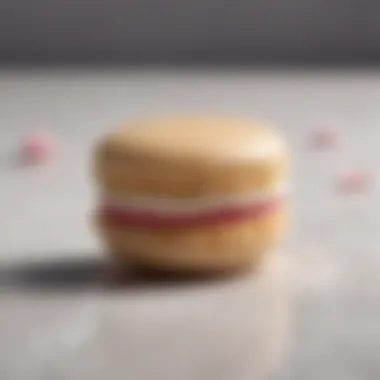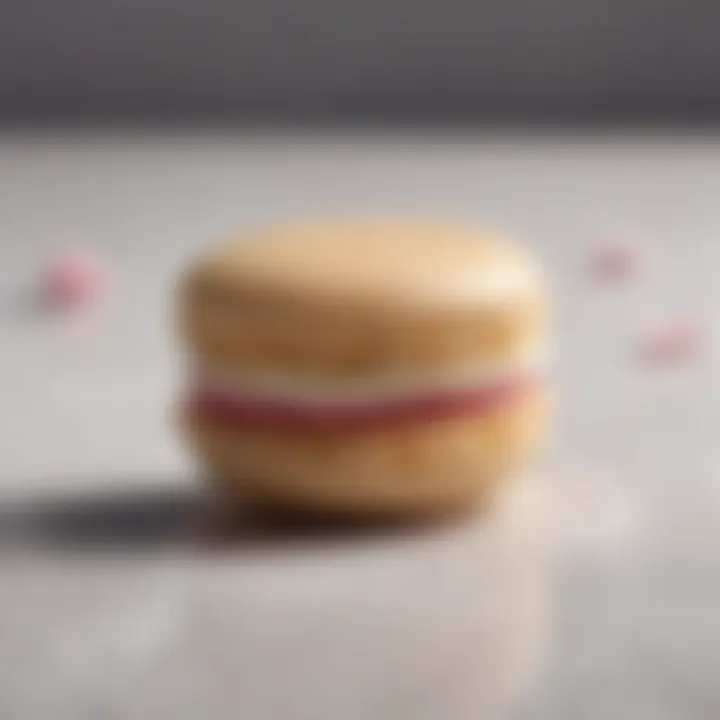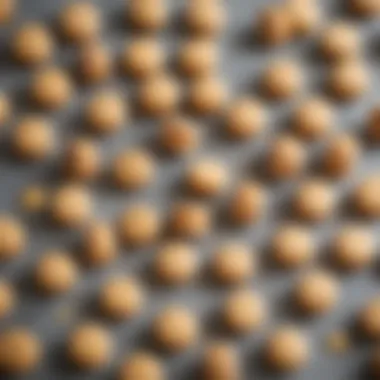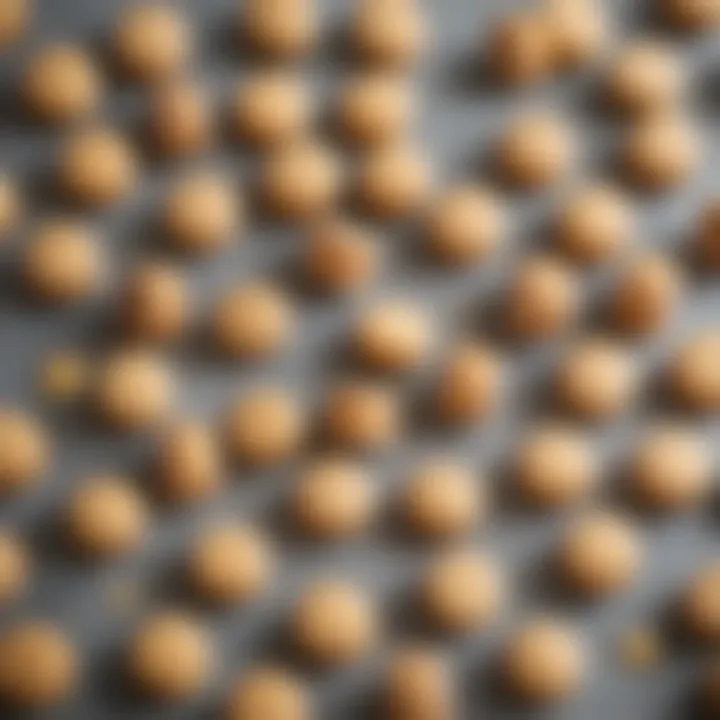Gluten Free Macaron Recipe: A Detailed Guide


Intro
Gluten-free macarons present not only a delightful treat but also an opportunity for bakers to innovate. The creation of these meringue-based cookies is often seen as a challenge, yet the results are both impressive and rewarding. In this guide, we will dissect the process into manageable steps, ensuring that both novices and seasoned bakers can achieve macarons that are not only beautiful but also delicious.
The nuances of this delicate confection lie in its ingredients, methods, and subtle science. Mastery of macarons involves more than just following a recipe; it requires understanding the relationships between ingredients and the techniques involved in preparation. This guide encompasses everything from selecting the right ingredients to troubleshooting common issues that arise during baking.
Throughout this article, we will explore various elements such as different flavor profiles, tips on how to store these treats effectively, and a glance at the cultural significance of macarons within the pastry world. Whether you aim to serve these elegant cookies at a gathering or simply savor them yourself, this comprehensive guide is designed to elevate your baking experience and enhance your culinary repertoire.
Intro to Gluten-Free Macarons
Understanding gluten-free macarons is a vital step for those who enjoy baking and want to accommodate dietary restrictions. The rise of gluten sensitivities and celiac disease has escalated the demand for delicious gluten-free alternatives. This section will explore the essence of macarons, what makes them unique, and why gluten-free options are crucial.
What are Macarons?
Macarons are delicate French confections made from almond flour, egg whites, and sugar. They have a smooth, shiny surface and soft texture, which makes them quite different from other treats like cookies. Typically, macarons come as two distinct shells filled with various fillings such as buttercream, ganache, or jam. The culinary art of creating macarons can be intricate, yet the results are rewarding for both the palate and the eye.
Significance of Gluten-Free Options
The significance of gluten-free macarons lies in inclusivity and health. For individuals with gluten intolerance or celiac disease, traditional baked goods can pose health risks. Offering a gluten-free macaroon option can bring joy to those who have these conditions, ensuring they can indulge in life's sweet experiences.
Additionally, the use of gluten-free almond flour makes macarons a naturally gluten-free treat, maintaining their characteristic flavor and texture without compromising quality. This adaptability not only meets dietary needs but also paves the way for innovative recipes and flavors. As the culinary landscape evolves, understanding gluten-free options will increasingly become an integral part of modern baking.
Ingredients Overview
The success of any macaron, particularly gluten-free ones, hinges on selecting the right ingredients. Instead of relying on all-purpose flour, gluten-free macarons use almond flour, which contributes both flavor and texture. Understanding the essential ingredients is critical. It is important to consider not just how they interact with each other, but also their role in the overall flavor profile and structure of the macaron. Each element must be chosen carefully to achieve the desired results.
Essential Ingredients for Macarons
When crafting macarons, three primary ingredients are central to the recipe:
- Almond Flour: This is a key ingredient. Its fine texture creates a delicate shell. Opt for finely ground almond flour to avoid a gritty texture.
- Egg Whites: They form the base of the meringue. Freshness is crucial; aim to use room temperature egg whites for better volume.
- Powdered Sugar: This adds sweetness and plays a role in smoothing out the batter. The tiny particles help create the necessary consistency.
Combining these components in the right proportions yields a stable macaron structure with the iconic smooth surface.
Choosing Gluten-Free Almond Flour
Selecting almond flour requires some care. Not all almond flours are created equal. The best choices are those marked as finely ground. Coarser varieties can lead to uneven texture. It's also wise to check for any cross-contamination with gluten-containing products. Look for certified gluten-free brands, such as Bob's Red Mill or King Arthur, to ensure safety. The flavor of the almond flour itself is another consideration; a slightly bitter taste can affect the overall flavor of the macaron.
Flavoring and Coloring Agents
Flavoring and coloring agents personalize the macaron experience. Consider these options:
- Extracts: Vanilla, almond, and citrus extracts can enhance the flavor profile. They should be used sparingly to avoid overpowering the delicate meringue.
- Food Coloring: Gel or powder forms are ideal, as they do not add moisture like liquid dyes. This helps maintain the stability of the batter.
- Natural Ingredients: For those who prefer natural flavoring, ingredients like matcha powder, cocoa powder, or fruit purees can be incorporated. However, balance is key. Overloading the batter may compromise the macaron’s structure.
Macaron Preparation Steps
The preparation steps for macarons are critical to achieving the right texture and flavor. Each stage of this process influences the final result of your delicate treat. Understanding these steps ensures that you handle your ingredients properly, contributing to the success of your gluten-free macarons. A careful approach allows both beginners and experienced bakers alike to produce consistently delightful macarons.
Preparing the Meringue
Meringue is the foundation of macarons. It is created by whipping egg whites to a frothy peak, then gradually incorporating sugar. The two principal types of meringue used in macaron making are French meringue and Italian meringue. French meringue is simpler and often used in home kitchens. The egg whites must be at room temperature for optimal volume. Once the meringue reaches stiff peaks, it should be glossy. If it is dry or overmixed, the macarons can end up with cracks.


Here are some crucial tips to consider:
- Quality of Egg Whites: Fresh, room-temperature egg whites will give better volume.
- Avoiding Grease: Ensure your mixing bowl and whisk are clean and free of grease to avoid volume loss.
Mixing the Batter
Mixing the batter involves carefully folding the meringue with the dry ingredients. This step is crucial; overmixing or undermixing can lead to poor results. A proper batter should flow like magma, smoothly and steadily.
Macaronage Technique
The macaronage technique refers to the specific folding method used to combine ingredients. It requires a gentle but firm approach to ensure the mixture retains air without being deflated. The technique's main functionality is to balance moisture and structure in the batter, which is necessary for the perfect macaron. This controlled folding helps distribute the color and flavor evenly while maintaining the light texture.
The unique feature of this technique is the observation of the batter's consistency. If perfected, macarons achieve a stable, smooth surface. However, an insufficient macaronage can result in peaks that do not smooth out during baking, while overmixing can lead to hollow shells. Therefore, mastery of this technique is fundamental to the desired outcome.
Testing the Batter Consistency
Testing the batter consistency is an integral part of the mixing process. You can conduct the test by drawing a figure eight with the batter; if it flows without breaking, it is ready. This characteristic is essential because it ensures your macarons can rise properly during baking and form the characteristic feet.
Correct consistency contributes significantly to the reliability of outcomes. Accurate tests will lead you to produce consistently successful macarons while avoiding disappointments like cracked tops or other deformities.
Piping the Macarons
Piping the macarons is the final step before baking. Using a piping bag fitted with a round tip, you should apply even pressure to create uniform circles on parchment paper. Control is key in this step; the spacing between each macaron should be adequate to allow them to spread slightly.
One crucial technique involves slightly lifting the piping bag from the surface after each squeeze. This will help prevent the formation of peaks, resulting in smooth, rounded macarons. Practice is important here, and patience will result in the best possible outcome.
Baking Process
Understanding the baking process is essential in creating perfect gluten-free macarons. The baking phase is where all your preparations come together. A well-executed baking process can result in macarons that are not only appealing to the eye but also deliver the desired texture and flavor. Proper oven temperature and timing play a pivotal role in achieving this outcome.
Oven Temperature and Timing
Baking macarons requires precision. An oven that is too hot may cause the shells to rise too quickly, leading to cracks. Conversely, if the temperature is too low, the macarons may not develop the characteristic foot at the base, which is a sign of a well-baked macaron. A typical recommended temperature for gluten-free macarons is around 300°F (150°C), but this may vary depending on your oven.
When baking, it is also important to use an oven thermometer to verify your oven's actual temperature, as it may not always align with the dial setting. Time is equally critical; generally, macarons bake for 12 to 15 minutes. A good rule of thumb is to observe the feet as they develop and to ensure the tops do not change color significantly.
After finishing the baking, you can do a simple test. Lightly touch the top of a macaron; it should feel firm and not stick to your finger. Timing and temperature should be adjusted based on how your macarons perform under your specific conditions.
Cooling Techniques
Once the macarons are done baking, cooling them down correctly is crucial. The cooling phase is not just about letting your macarons rest. According to many bakers, cooling them directly on the baking sheet helps maintain the shell's integrity while ensuring that they do not lose moisture.
It is suggested to let the macarons sit for about 10 minutes on the baking sheet before transferring them to a cooling rack. This allows for the shells to set further. When you transfer them, use a spatula to lift them carefully to avoid any breakage.
Finally, let the macarons cool completely to room temperature before filling them. This helps prevent any potential melting of fillings like buttercream or ganache.
"Patience is key when it comes to baking macarons; don’t rush the cooling process."
Filling Options
Filling options play a crucial role in the overall experience of gluten-free macarons. The filling not only complements the delicate shell but also defines the flavor profile of the macaron. Selecting the right filling can elevate the taste and make a memorable treat. With various choices available, it is important to consider the balance between flavor, texture, and aesthetics.


Common Fillings for Macarons
Buttercream Variations
Buttercream variations are a prominent choice for macaron filling due to their versatility and richness. They can be flavored in numerous ways, such as vanilla, chocolate, or matcha, allowing for customization based on personal preferences. The smooth texture of buttercream provides a lovely contrast to the lightness of the macaron shell. One strong characteristic of buttercream is its ability to hold its form well, making it suitable for piping into the macarons.
However, caution must be taken with the sweetness level. Some may find traditional buttercream overly sweet, which could overshadow the flavor of the macaron shell. To achieve balance, consider incorporating a hint of salt or using less powdered sugar. The key benefit of buttercream is its adaptability, as it can be tailored to suit various flavor combinations, enhancing the overall macaron experience.
Ganache Recipes
Ganache recipes present another exceptional filling option for macarons. Made from heavy cream and chocolate, ganache offers a rich and decadent texture. A notable aspect of ganache is its ease of preparation, requiring only two key ingredients. This makes it an accessible choice for many bakers. Furthermore, ganache can be infused with flavors like coffee, orange zest, or even spices, providing additional layers of taste.
The unique feature of ganache is its smooth and creamy texture that melts in the mouth, creating a delightful contrast to the macaron shell. However, one must consider the consistency. Ganache may become too soft if not properly cooled. For the best results, allow the ganache to set before filling the macarons. Ganache serves as an excellent option for those who enjoy richness and depth in dessert flavors.
Fruit Preserves
Fruit preserves are an innovative filling that can add a refreshing twist to macarons. They bring natural sweetness and vibrant flavors to the confection. Common choices include raspberry, apricot, or lemon preserves, each offering unique taste experiences. The key benefit of fruit preserves is their ability to enhance the macaron without overwhelming it, maintaining the delicate balance of flavors.
The unique feature of using fruit preserves is the tartness they can introduce, which acts as a palate cleanser between bites. While fruit preserves can provide a lighter option, it is important to ensure the filling is not too runny. This may lead to messy macarons. To counter this, one can mix preserves with a small amount of butter or cream cheese to achieve the desired consistency. Fruit preserves serve as a delightful option for those who prefer a zestier flavor profile.
Innovative Filling Ideas
Baking can be an artistic outlet, and exploring innovative filling ideas can broaden the horizons of macaron flavor profiles. Consider unique combinations such as pistachio cream with dark chocolate ganache or matcha buttercream with yuzu curd. Mixing and matching different flavors and textures not only surprises the palate but also elevates the overall experience.
Common Challenges in Macaron Making
Baking macarons is not just an art; it is a meticulous science. While gluten-free macarons are undoubtedly delightful, their preparation may often present pitfalls that can lead to inconsistent results. Recognizing these challenges is crucial for both novice and experienced bakers. By understanding the common problems faced when making macarons, bakers can better troubleshoot issues, ensuring a successful outcome. This guidance serves to demystify the process and enhance overall baking confidence.
Cracked Tops
Cracked tops on macarons can be frustrating for any baker. The appearance of cracks can detract from the delicate presentation of these confections. Often, cracked tops indicate that the batter was overmixed or that the macarons were baked at too high a temperature. To avoid this issue, it is vital to monitor both the mixing consistency and the oven settings closely. Achieving the right texture in the batter can help maintain a smooth surface.
To prevent cracked macarons:
- Ensure proper mixing of ingredients to form a cohesive batter without overworking it.
- Adjust the oven temperature as necessary, knowing that excessive heat can lead to rapid expansion and cracking.
- Allow macarons to rest on the baking sheet before baking, which can help form a skin and prevent cracks during baking.
No Feet Formation
A hallmark of a well-made macaron is its foot, the frilled base that forms during baking. The absence of feet can render an otherwise perfect macaron a disappointment. This often occurs due to inadequate resting time before baking or improper piping technique. Resting allows for a skin to form, which is crucial for proper foot development.
To encourage foot formation:
- Rest the piped macarons at room temperature for 30 to 60 minutes. This step is essential for the skin to form.
- Use a consistent technique when piping to ensure even and uniform shapes. Uneven shaping can affect how the macarons rise in the oven.
- Make certain to pipe onto silicone mats or parchment paper for a better grip and even baking.
Hollow Shells
Hollow shells indicate that the macaron’s structure lacks stability. This can happen due to under-mixing or insufficient meringue development. The shells may rise, but their internal structure does not hold, leading to hollowness. Ultimately, the texture is affected, making the macarons less enjoyable.
To avoid hollow macarons:
- Utilize a stable meringue by whipping egg whites to stiff peaks, ensuring that there is adequate structure to support the batter.
- Be attentive during the macaronage process. Undermixing can create air pockets that do not stabilize during baking.
- Pay close attention to oven temperature and baking time, ensuring that macarons are thoroughly baked without being overdone.


A successful macaron relies on precision in technique and a willingness to learn from challenges encountered along the way.
Cultural Context of Macarons
Understanding the cultural context of macarons enriches both the appreciation and the crafting of this exquisite treat. Macarons are not merely pastries; they symbolize artistry and culinary tradition. Their elegant structure and delicate flavors connect us to various regions and their histories. For individuals who bake gluten-free options, these historical roots and modern significance can influence their approach to the recipe in profound ways. The cultural aspects can motivate bakers to honor the origins of macarons while also pushing the boundaries of flavor and presentation.
Historical Background
The macaron has a rich history that traces back to Italy in the 8th century, where it was first introduced as a simple almond meringue cookie. Yet, it was the French who truly perfected the macaron, transforming it into the colorful and nuanced creations we know today. This transition came primarily in the 19th century when noble families in France began to enjoy pastries made with almond flour, egg whites, and sugar, setting the stage for what would become the modern macaron.
"The macaron is a cultural artifact, embodying centuries of culinary evolution and idiosyncratic regional variations."
In contemporary baking circles, the macaron symbolizes not just skill but also creativity. Bakers often experiment with fillings, flavors, and designs. This evolution showcases an interaction between tradition and innovation, as the original recipes influence modern interpretations.
Macarons in Modern Cuisine
In modern cuisine, macarons have transcended their traditional role as a simple dessert to become a staple in fine dining and casual culinary experiences alike. Their visual appeal and diverse flavor profiles make them adaptable to various trends. Seasonal flavors, such as pumpkin spice in the fall, or floral notes in spring, reflect current culinary movements. Moreover, the heightened awareness of gluten-free diets has caused a notable increase in gluten-free macarons, which maintains the integrity of the original recipe while catering to dietary restrictions.
The advent of social media has also contributed to the macaron's prevalence, with platforms like Instagram showcasing elaborate designs and innovative flavors. Notably, the French macaron has been embraced globally, leading to regional adaptations that infuse local ingredients and tastes.
The intersection of tradition, visual art, and modern dietary preferences makes macarons a unique and fascinating subject in contemporary baking. Their position within both cultural and culinary narratives underscores their timeless appeal. Whether enjoyed at a high-end patisserie or made at home, gluten-free macarons continue to captivate bakers and food lovers alike.
Storage and Shelf Life
Understanding how to properly store gluten-free macarons is crucial for maintaining their texture, flavor, and overall quality. Unlike many traditional baked goods, macarons are sensitive to environmental conditions. Humidity and temperature fluctuations can affect their delicate shells and fillings. Therefore, proper storage practices are essential to prolong their freshness and ensure an enjoyable taste experience.
Best Practices for Storing Macarons
To keep gluten-free macarons at their best, consider the following best practices:
- Airtight Containers: Use airtight containers to protect macarons from moisture and odors. Plastic containers with tight seals or glass jars work well.
- Layering with Parchment Paper: If stacking macarons, place parchment paper between layers to prevent sticking.
- Cool Environment: Store macarons in a cool, dry place away from direct sunlight, which can alter their flavor and color.
- Freezing for Longevity: For longer-term storage, macarons can be frozen. Wrap them carefully in parchment paper and place them in an airtight freezer bag. Ensure to layer them to prevent damage.
Understanding Shelf Life
The shelf life of gluten-free macarons varies depending on ingredients and storage methods. Generally, macarons can be kept at room temperature for 3 to 5 days if stored properly. When refrigerated, they can last up to a week. However, for optimal taste and texture, consuming them fresh is recommended.
When macarons are frozen, they can last up to three months. When ready to consume, let them thaw in the refrigerator for a few hours before bringing them to room temperature. This process helps retain their unique texture.
Proper storage is key to delivering the best taste experience with your gluten-free macarons. Don’t overlook this important step in your baking journey.
Culmination
In this article, we have explored the intricate details of creating gluten-free macarons, emphasizing the importance of each step. A conclusion serves as a summary that synthesizes the knowledge gained throughout the article. It reinforces the core elements that contribute to the success of this delicate treat.
Recap of Key Steps
To ensure successful macaron-making, several crucial steps cannot be overlooked:
- Ingredient Selection: Using high-quality gluten-free almond flour and ensuring all other ingredients are gluten-free is fundamental.
- Meringue Preparation: Achieving the right meringue consistency is vital. Underwhipping or overwhipping can lead to structural issues in the final macaron.
- Gentle Folding: Mixing the dry ingredients with meringue using the macaronage technique is crucial for proper texture.
- Piping Technique: Mastering the piping ensures uniformity in size and shape, a characteristic feature of macarons.
- Baking Conditions: Maintaining correct oven temperature and timing guarantees that macarons develop their feet and do not dry out.
These steps create a clear roadmap for bakers, making the macaron-making process methodical and achievable.
Encouragement for Experimentation
Experimentation is essential in baking, particularly when making macarons. While the basic recipe provides a strong foundation, creativity can lead to unique and personalized variations. Consider these avenues for exploration:
- Flavor Combinations: From classic flavors like vanilla and chocolate to daring choices like lavender or matcha, the possibilities are endless.
- Color Techniques: Leverage natural food coloring or create marbled effects to enhance visual appeal.
- Filling Innovations: Explore unconventional fillings, like salted caramel or pistachio ganache, to set your macarons apart.
Baking is an art! Finding the balance between tradition and innovation only elevates the experience, enhancing flavor and enjoyment.







